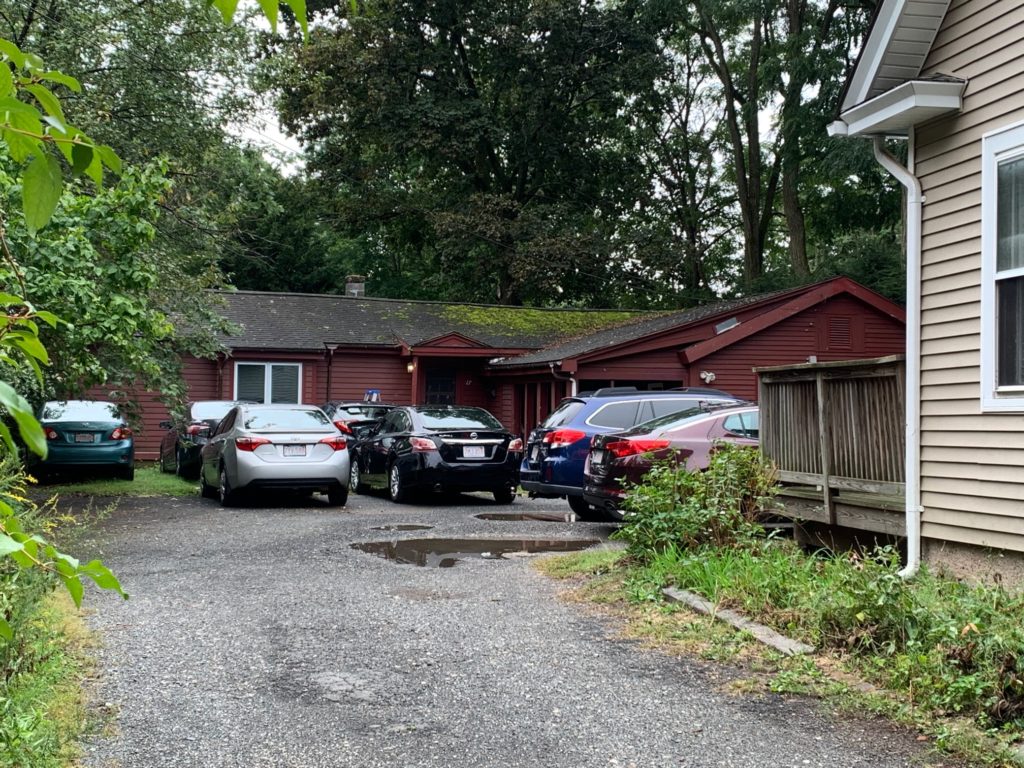Opinion: When It Comes To Student Rentals, More Is Less

Parking in front of student rental property Photo: Art Keene
This column appeared previously in The Amherst Bulletin.

During a discussion of the residential rental property bylaw at the July 28 meeting of the Amherst Community Resources Committee, some members expressed support for increasing the number of unrelated individuals (i.e., students) permitted to rent a non-owner-occupied dwelling.
This proposal is perplexing, especially in view of neighborhood resident responses to a recent Engage Amherst online survey, which cited overcrowding in student rentals as a major concern they’d like the bylaw revisions to address.
The following rationales were offered for increasing the number of student tenants per dwelling and my response to each:
- “It’s more equitable to allow more roommates to share the rent.”
Most landlords charge per bedroom and per tenant. It’s not as though a house is advertised at $4,000 a month no matter how many tenants reside there. One particularly egregious landlord owned three houses on the 300 block of Lincoln Avenue and rented each to eight students, charging more than $7,000 a month per house. The block quickly descended into bedlam. Between the three houses, there were at least 24 tenants. When each had a guest or two, that brought an additional 48-72 people to a small block, with cars coming and going (and backyard and front lawn gatherings), well past the time their non-student neighbors turned in for the night.
- “If a house has more than four bedrooms, why should some go unused?”
The surrounding non-student households will be even more adversely impacted by more students with more cars than the current law allows and many more of their guests at all hours of the day and night. The current law, while not perfect, at least makes an attempt at a balanced neighborhood of families, seniors, non-students and students.
The more insidious issue is that once landlords can rent a single property to more tenants, it makes the whole enterprise that much more profitable. As it is, investors are outbidding regular folks when houses go up for sale. Once it becomes even more lucrative for landlords to rent to six to eight (or more) students instead of four, investor-owned properties will only increase to the detriment of all the others who have an interest in maintaining balanced neighborhoods.
- “Tenants in houses with more than four roommates may be reluctant to call inspectors regarding health and safety violations, for fear of being cited for exceeding the four-tenant limit.”
To “fix” a violation by getting rid of the regulation that is being violated is like lowering the drinking age to reduce under-age drinking.
Whatever the allowable number of tenants, there will always be some houses with more roommates than permitted. Increase the limit to six and you’ll have eight, and on it goes. To “fix” a violation by getting rid of the regulation that is being violated is like lowering the drinking age to reduce under-age drinking.
Allowing landlords to increase the number of tenants per dwelling will not lower our property taxes, but it could well drive neighboring families and other non-student households out of Amherst forever. Some may have no objection to long-term residents vacating neighborhoods to make way for more student rentals. They may even favor this “solution.” UMass gets the housing it doesn’t provide for its students; investors reap higher profits per rental unit; and life continues undisturbed for those residing in our most protected enclaves and in those areas of town not yet targeted by absentee investors.
Of course, this is all very short-sighted. No matter where in Amherst one resides, it’s not in the town’s long-term interest to continue losing year-round residents. As the 2020 census revealed, Amherst’s non-student population is declining. And a town comprised mostly of student rentals doesn’t pay. Amherst, with a population of roughly 39,000 (approximately 25,000 of them students) has an annual operating budget of roughly $90 million. Our neighbor, Northampton, with a population of just under 28,500, has an annual operating budget of close to $126 million. Losing more year-round residents is not the answer to our budgetary shortfalls.
To remain a healthy, viable and attractive town, we need families that send children to our K-12 schools, year-round residents to support a 12-month economy, patrons for our new library, and a robust population of year-round residents who serve on our boards and commissions and are invested in the long-term wellbeing of Amherst.
During the July 28 CRC meeting, I was told that “neighborhoods change.” Yes, that is undoubtedly true. But is the loss of our long-standing, family-friendly neighborhoods to ones populated primarily by absentee-owned student rentals (in which the occupants move every nine-12 months) really the change that we want — or need?J
Jennifer Taub is an Amherst town councilor representing District 3 and member of the Community Resources Committee.

Thank you for this insight, it is thought provoking.
I think it is wrong for landlords to charge per person, it drives the rent in town too high. I live in an 850-square-foot apartment with my husband and son. The students in the neighborhood are not a problem, but the rent is too high. I pay $1150 for my tiny two-bedroom. Something has to be done to change the high rental prices.